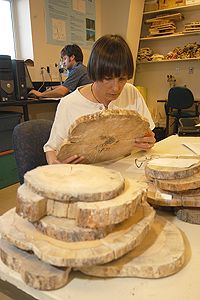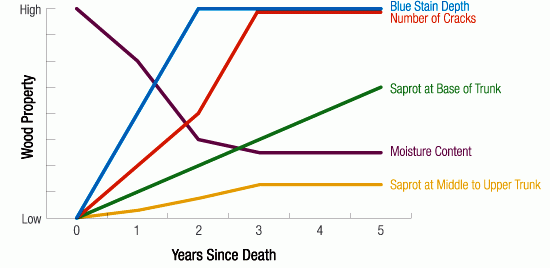Research Examines Shelf Life of Beetle-Infected Trees
August 24, 2006
Research conducted at the University of Northern British Columbia has quantified the significantdecline in wood quality in trees killed by the mountain pine beetle. Theresearch was funded by the Government of Canada’s Mountain Pine BeetleInitiative and is one of the first studies that focus on the rate ofdeterioration and fall of lodgepole pine infected by the beetle in British Columbia.

Research conducted at the University of Northern British Columbia has quantified the significantdecline in wood quality in trees killed by the mountain pine beetle. Theresearch was funded by the Government of Canada’s Mountain Pine BeetleInitiative and is one of the first studies that focus on the rate ofdeterioration and fall of lodgepole pine infected by the beetle in British Columbia.
Led by UNBC Forestry professor Kathy Lewis (pictured at left), theresearch team has determined that the greatest changes in wood quality occurwithin the first two years of mortality. These changes include significantdeclines in wood moisture accompanied by a large increase in the prevalence ofblue stain, the number and depth of cracks in the wood, and rot at thebase. After this initial decline in woodquality, however, there is only minor additional degradation before the treefalls down. Actual tree fall appears tooccur later in central BC ( > 10 years) than in other areas where pinebeetle research has been conducted. Researchers examined a total of 450 dead trees located invarious areas southwest of Prince George. Byanalyzing tree rings, the sample trees were cross-dated against live trees to preciselydetermine their year of mortality.
“To reduce the impacts of the current and futuremountain pine beetle outbreaks, it’s important to know the relationship betweentime-since-death and the factors that affect wood quality,” says Dr. Lewis., a 1996 BC Forester of the Yearaward recipient. “We’re not saying thatafter two years the wood is of no use, but the changes in wood quality affectthe range of wood products that can be manufactured and the technologies used forproduction. This information is vital to planning the timing and distributionof salvage harvesting operations to recover the greatest-possible value fromthe wood.”
The results were announced today in Prince George at a Beetle ResearchForum hosted by Natural Resources Canada. The present mountain pinebeetle outbreak in the central interior of British Columbia isconsidered the largest outbreak ever in North America. It is affectingan area in excess of 8.5 million hectares.

Click here to download high-resolution EPS version.
Contact:
Kathy Lewis, Forestry professor, UNBC - 250.960.6659
Doug Thompson, Researcher, UNBC - 250.960.6807
Rob van Adrichem, Director of Media and Public Relations, UNBC - 250.960.5622